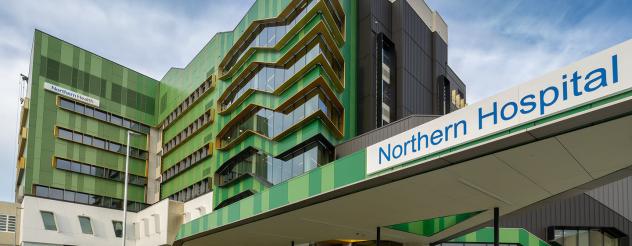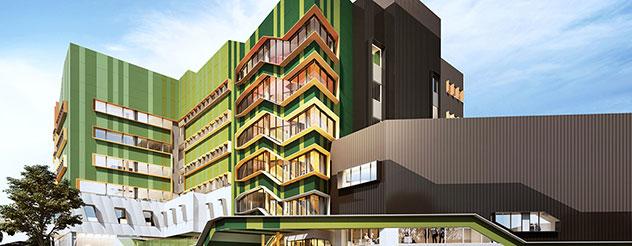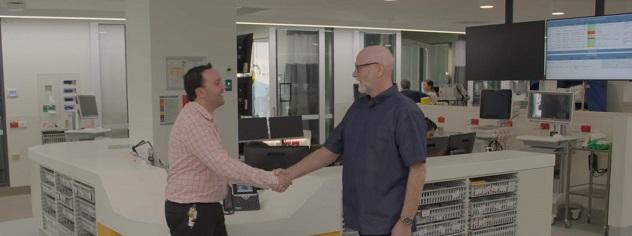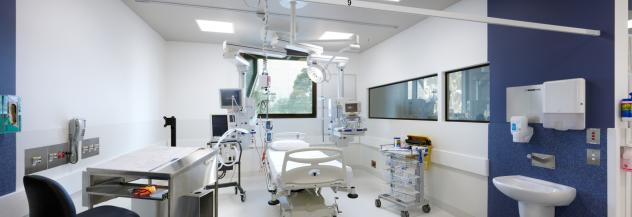
- Home
- News and events
- Improving patient experience at the Northern Hospital's new intensive care unit
Improving patient experience at the Northern Hospital's new intensive care unit
Northern Hospital's new state-of-the-art ICU forms part of a massive $162.7 million expansion designed to meet growing demand in the outer north.
In this video Dr Anthony Cross explains how the new intensive care unit at Northern Hospital has improved patient experience and made it easier for clinicians to care for their patients.
Learn more about the Northern Hospital expansion via our dedicated project page.
Accessible video transcript
"The patients who come to the intensive care unit are the sickest patients in the community at the time, so it’s important they are cared for in a state-of-the-art unit.
IMAGES: An elderly lady in a hospital gown is hooked up to an intensive care machine with a monitor. A nurse wearing purple scrubs and a pink hijab is warmly holding her hands, and an elderly man smiles at them. Dr Anthony Cross, ICU Director at the Northern Hospital is shown talking to the camera in front of ICU equipment. He has a stethoscope around his neck.
"And I think in the development of the Northern Hospital intensive care unit we really have been able to put a lot of features in which enable us to give the highest quality, safest care that the patients of our community deserve and require.”
IMAGES: A section of the Northern Hospital’s facade is shown against a blue sky. Then a sign is shown with an arrow pointing to the ICU. A hospital bed, a stethoscope and a sunlit hallway in the hospital are shown.
“Being in an intensive care unit where’s there is noise and light and action 24 hours a day, seven days a week – it’s a bit like jetlag – on steroids. We know that we can decrease that by trying to replicate a normal environment as much as possible.”
IMAGES: A team of staff in blue scrubs walks through a hallway. The nurse in the pink hijab types patient details into a touch screen. “So one of the features that people like about this is the switchable film on the windows, which allows us to change the windows from opaque to completely transparent, so the patient can look outside and see what’s going on in the world.”
IMAGES: Frosted glass windows in an ICU bay switch to transparent, revealing a blue sky and a brick building outside. “The other thing is sound control. We need it to be quiet at night so that the patients can sleep. All those things contribute to a more speedy and more complete recovery.”
IMAGES: Hospital beds and a high-tech monitoring system are shown.
“From a clinician’s point of view, the intensive care unit is set up around a central staff area such that all the bays have good visibility such that staff outside the bay can see into the room to see what’s going on and render assistance if necessary.”
IMAGES: The nurse sits on a chair talking to Dr Cross, who is standing and nodding. A staff station is shown with desks, screens and computers. A woman in scrubs sits at one of the computer desks. “We need fully-functioning ICUs like this with a lot of infrastructure in it to support all the other things that go along with caring for critically ill patients."
IMAGES: Dr Cross talks to a woman in a white dress. The nurse uses a touch screen monitor and talks with the elderly female patient wearing a nasal tube, who is laughing and smiling.
IMAGES: A white screen with text that says ‘In partnership with Northern Health’. The next screen is blue with text that says: ‘Victorian Health and Human Services Building Authority, Victorian State Government, vhhsba.vic.gov.au’.
The next screen is black with text that says: ‘Authorised by the Department of Health and Human Services 50 Lonsdale Street, Melbourne. Spoken by A. Cross’.
Related content

25 January 2022
Northern Hospital expansion - Stage 2
The Victorian Government invested $162.7 million to expand the Northern Hospital.
27 March 2019
Northern Hospital opens world-class intensive care unit
Critically ill patients now have access to world-class intensive care with the opening of Northern Hospital’s $22 million intensive care unit (ICU).
09 September 2019
Northern Hospital's new intensive care unit - A patient's perspective
Shaun Carey has been in the Northern Hospital intensive care unit four times over the last 12 months. He explains how he watched the new unit being built.
17 November 2017



